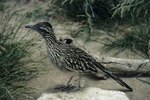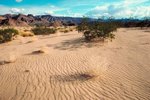
Desert animals are exposed to scorching hot temperatures for long periods of time. Deserts receive very little rainfall so animals who live in the desert get their water from food sources when water holes and natural rainfall are scarce. Desert animals have special adaptations that allow them to survive extreme heat. Their bodies are capable of storing water and naturally absorbing it when needed.
Ostriches Stay Above the Heat

The ostrich has long legs and a long neck that keeps their body away from the hot desert ground. The gap between the desert floor and the ostrich's body allows the ostrich to avoid direct heat steaming up from the desert sand. Ostrich's retain water for future use by defecating and urinating extra-concentrated toxins from their bodies using a special mucus that their body produces. They also slow their air passage through a two-chambered nasal passage to remove water vapor.
Sand Gazelles Lose Less Water

Sand gazelles have the lowest amount of water loss among other hoofed animals living in the desert. Their bodies allow them to breathe less by shrinking their heart and liver, causing prevention of moisture loss and retaining water in their system. Sand gazelles are also able to absorb urine and reuse it as a water source, in small amounts back into their body.
Camels Use Fat to Store Water

Camels have humps on their back filled with fatty tissue, not water. But one gram of fat is equivalent to one gram of water when metabolized. Storing fat in their humps, instead of having the fat distributed evenly throughout their entire body, allows the camel to keep cool. Otherwise, the overall body fat would act as insulation and cause extreme heat within the camel's body. The fatty tissue in the hump is a source of energy and water that the camel uses when needed. A camel's hump will swell when it is packed full of fat and deplete as the stored fatty tissue is used to hydrate and energize the body.
Giraffes Beat Camels

Giraffes can go longer periods of time without drinking water than a camel. Giraffes get most of their water intake from plant sources. Acacia leaves are the main plant food source for giraffes. They only drink water once every few days. Their bodies do not have resources to store water. However, their plant diet is plentiful and provides a large portion of their water intake.
References
Resources
Photo Credits
-
Digital Vision./Photodisc/Getty Images
Writer Bio
Based in Miami, Shellie Alyssa has been writing articles since 2011. Her articles have appeared on a variety of popular and informative pet websites including munch.zone. In 2000, she was awarded an editors choice award for Outstanding Achievement in Poetry from the International Library of Poetry. She holds a fashion merchandising diploma from Penn Foster College.




